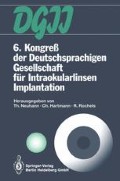Zusammenfassung
Seit Juni 1991 haben wir in der Universitäts-Augenklinik Düsseldorf in 3 Augen mit kongenitaler Aniridie und Katarakt und in 4 Augen mit traumatischer Aniridie und Aphakie oder Katarakt eine zusammen mit der Fa. Morcher entworfene Hinterkammerlinse mit Irisblendenfunktion in den Sulcus ciliaris eingesetzt oder bei fehlenden Kapselsackstrukturen dort eingenäht.
Intraoperativ war insbesondere bei traumatischer Aniridie und in Kombination mit perforierender Keratoplastik das Einführen und korrekte Positionieren der sehr großen Linse sehr schwierig.
Postoperativ hatten wir in zwei Fällen im bisherigen Beobachtungszeitraum von bis zu 9 Monaten mit einem vorbekannten und postoperativ dekompensierten, konservativ jedoch gut beherrschbaren Sekundärglaukom zu tun. In einem weiteren Fall einer postoperativen Drucksteigerung mußte fistulierend operiert werden. Ob und in welchem Ausmaß ein chronischer Endothelzellverlust auftritt, werden die weiteren Untersuchungen zeigen. Ein zystoides Makulaödem ist bisher in keinem Fall aufgetreten. In allen Fällen war ein wesentlicher Visusanstieg nachweisbar.
Eine Implantation dieser potentiell risikoträchtigen Irisblenden-Intraokularlinse sollte nur in spezialisierten Zentren vorgenommen werden.
Summary
Since June 1991 we have implanted a new intraocular lens with an artificial iris diaphragm into three eyes with congenital aniridia and cataract and into 4 eyes with traumatic aniridia and aphakia or cataract.
Intraoperatively we experienced considerable difficulties in positioning the large lens, especially in all cases with traumatic aniridia and simultaneously performed keratoplasty.
Postoperatively three traumatic cases required glaucoma treatment. Two cases responded to medical therapy, one case had to undergo surgery. Up to now there has been no cystoid macula edema nor an endothelial cell loss. However, the follow-up period is too short for a valid judgement.
This potentially risky and certainly difficult operation should be performed in special centres only.
Access this chapter
Tax calculation will be finalised at checkout
Purchases are for personal use only
Preview
Unable to display preview. Download preview PDF.
Literatur
Alger L (1945) The cause and treatment of poor vision in aniridia. Am J Ophthalmol 28:730–735
Berens C (1936) The eye and its diseases. Saunders, Philadelphia
Dennis D (1906) Double congenital aniridia with glaucoma and cataract. Extraction with resulting good vision. Observations on the action of eserin where the iris is absent. Arch Ophthalmol 35:718–724
Elsas F, Maumenee I, Kenyon K, Yoder F (1977) Familial aniridia with preserved ocular function. Am J Ophthalmol 83:718–724
Heidenkummer H, Mangouritsas G, Kampik A (1991) Klinische Anwendung und Ergebnisse der transskleralen Nd-YAG-Zyklophotokoagulation bei therapierefraktärem Glaukom. Klin Monatsbl Augenheilkd 198:174–180
Heimann K, Konen W (1990) Künstliches Irisdiaphragma für die Silikonölchirurgie. Fortschr Ophthalmol 87:329–330
Johns K, O’Day D (1991) Posterior chamber intraocular lenses after cataract extraction in patients with aniridia. Ophthalmology 98:1698–1702
Küchle M, Naumann G (1990) Extrakapsuläre Kataraktextraktion und Hinterkammerlinsenimplantation bei Aniridie. 4. Band DGIT. 311–315
Layman P, Anderson R, Flynn J (1974) Frequent occurrence of hypoplastic optic disks in patients with aniridia. Am J Ophthalmol 77:513–516
Lewallen W (1958) Aniridia and related iris defects. Arch Ophthalmol 59:831–839
Mackman G, Brightbill F, Opitz J (1979) Corneal changes in aniridia. Am J Ophthalmol 87:497–502
Omi C, Almeida G ,Cohen R, Mandia C, Kwitko S (1991) Modified Schocket implant for refractory glaucoma. Ophthalmology 98:211–214
Rossa V, Sundmacher R (1991) Kontusionsbedingte traumatische Aniridie. Klin Mbl Augenheilk 199:444–445
Schulze F (1991) Irisrekonstruktion: Operation, Laser oder Kontaktlinsen mit Irisstruktur. Fortschr Ophthalmol 88:30–34
Schaffer R, Cohen J (1975) Visual reduction in aniridia. J Pediatr Ophthalmol 12:220–222
Vogt A (1924) Über angeborenes und vererbtes Fehlen der Macula lutea. Klin Monatsbl Augenheilkd 72:806
Editor information
Editors and Affiliations
Rights and permissions
Copyright information
© 1993 Springer-Verlag Berlin Heidelberg
About this paper
Cite this paper
Sundmacher, R., Reinhard, T., Althaus, C. (1993). Eine Hinterkammerlinse mit Irisblende für idiopathische und traumatische Aniridie. In: Neuhann, T., Hartmann, C., Rochels, R. (eds) 6. Kongreß der Deutschsprachigen Gesellschaft für Intraokularlinsen Implantation. Springer, Berlin, Heidelberg. https://doi.org/10.1007/978-3-642-50268-2_32
Download citation
DOI: https://doi.org/10.1007/978-3-642-50268-2_32
Publisher Name: Springer, Berlin, Heidelberg
Print ISBN: 978-3-642-50269-9
Online ISBN: 978-3-642-50268-2
eBook Packages: Springer Book Archive

